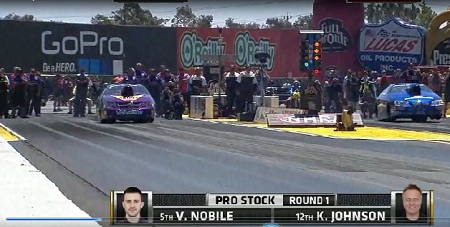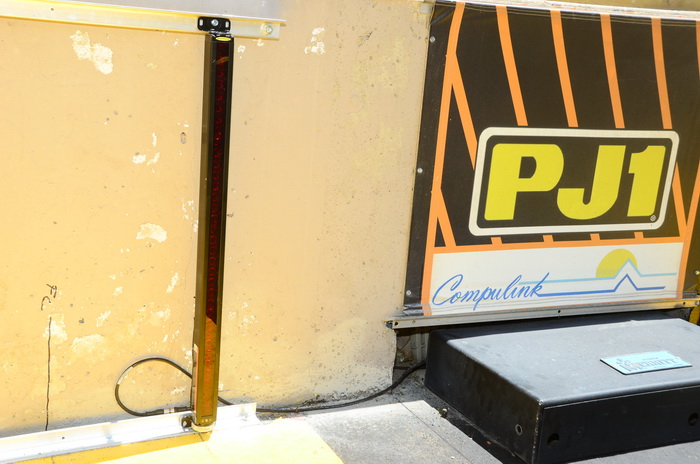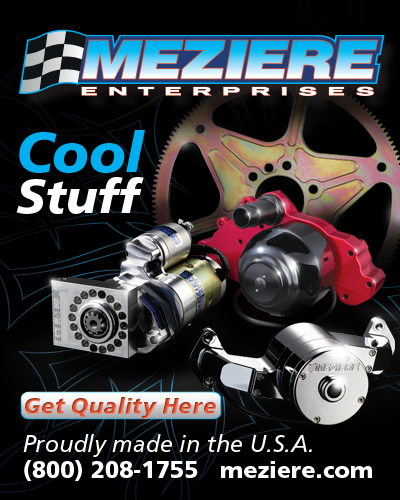COMPULINK FOUNDER EXPLAINS THE USE OF TIMING SYSTEM GUARD BEAM
When it comes to issues at the starting line, the NHRA has in place a part of the timing system to solve all those issues, and it isn't something new. But, it also isn't perfect.
The system is a device called the “guard beam.”
Brockmeyer took a moment to explain the guard beam to Competition Plus.com and how it caused the problem in Sonoma for Kurt Johnson.
“You have the pre-stage and stage beam,” Brockmeyer said. “13 3/8th’s of an inch down track from the stage beam you have the guard beam. Normally the front wheel breaks the stage beam and when it rolls through the stage beam it starts the clock. If you have a car, like Pro Stock, Pro Mod, Top Sportsman, whatever, (which takes off) basically dragging the ground that keeps the stage beam blocked. So, if the car hits that guard beam, and it stages the car, it is the same thing and limits the stage roll out to what we want.”
Brockmeyer said the guard beam was originally in place years ago.
 Compulink's Bob Brockmeyer believes the timing system fouled for Kurt Johnson when a foreign object broke the laser timing beams in Sonoma. NHRA declared Vincent Nobile the winner despite no definite explanation for Johnson's foul.When it comes to issues at the starting line, the NHRA has in place a part of the timing system to solve all those issues, and it isn't something new. But, it also isn't perfect.
Compulink's Bob Brockmeyer believes the timing system fouled for Kurt Johnson when a foreign object broke the laser timing beams in Sonoma. NHRA declared Vincent Nobile the winner despite no definite explanation for Johnson's foul.When it comes to issues at the starting line, the NHRA has in place a part of the timing system to solve all those issues, and it isn't something new. But, it also isn't perfect.
The system is a device called the “guard beam.”
Brockmeyer took a moment to explain the guard beam to Competition Plus.com and how it caused the problem in Sonoma for Kurt Johnson.
“You have the pre-stage and stage beam,” Brockmeyer said. “13 3/8th’s of an inch down track from the stage beam you have the guard beam. Normally the front wheel breaks the stage beam and when it rolls through the stage beam it starts the clock. If you have a car, like Pro Stock, Pro Mod, Top Sportsman, whatever, (which takes off) basically dragging the ground that keeps the stage beam blocked. So, if the car hits that guard beam, and it stages the car, it is the same thing and limits the stage roll out to what we want.”
Brockmeyer said the guard beam was originally in place years ago.
“People misunderstood what it did and didn’t do,” Brockmeyer revealed. “People didn’t understand it. They quit using it (the guard beam) just because of the fact that someone would blow through and cause a red light or whatever. Then about four years ago, NHRA was having trouble with Pro Stock times. They wanted to have the guard beam again and we moved it from its original position to where it is now (13 3/8th inches down the track).”
When first put into use Brockmeyer explained the guard beam was set 16 inches down the track.
“It was 16 inches because you had Super Stock cars with huge front tires,” Brockmeyer said.
Brockmeyer believes having the guard beam being 13 3/8ths inches down the track from the stage beam was a good move.
“It works great,” Brockmeyer said.
The Compulink timing system drew criticism from veteran Pro Stock driver Kurt Johnson when he registered a red light in his first round run against Vincent Nobile at NHRA’s Somona Nationals July 29.
“I believe what I see and I know I didn’t move first,” Johnson told ESPN2’s Dave Rieff. “Vincent was .006 red and I was two tenths. At 12 clicks you will be at a .00 [reaction] on the tree. I was at 13 clicks meaning I was .030 or .030 on the tree.”

“The numbers don’t add up and the car didn’t move,” said Johnson. “I basically got screwed on this one. The biggest thing is I don’t want it to happen again. We could use those 20 points.”
Brockmeyer admits Johnson was a victim of bad luck.
“Something blew through the guard beam,” Brockmeyer said. “It was a bug, trash, something. Something blew through the guard beam and staged the car and it went red obviously. We do not know what it was. The car pretty much didn’t move, something blew through it (the guard beam). Something tripped the guard beam. It was part of bad luck.”
During NHRA’s Mile-High Nationals at Bandimere Speedway, the weekend prior to Johnson's issues, Brockmeyer tested a new infra red wall technology which would change the way timing is done in the NHRA’s future. Brockmeyer is considering another test of the new infra red wall technology in the right lane-only at the U.S. Nationals Aug. 29-Sept. 3 in Indianapolis.
The new system will start from the front of dragsters, Funny Cars and motorcycles.
“The (infra red) wall technology will stop that completely,” said Brockmeyer about what happened to Johnson.
“I have a lot of data I’m still compiling, and it really showed good,” Brockmeyer said. “It showed more than I thought it would. We also did a bunch of Sportsman testing last weekend (at Bandimere Speedway). We are probably going to have to take some time at (Bandimere) and run some Friday night races. Then, maybe NHRA will allow us to do it at a divisional race and see what it does.”
Brockmeyer admitted the only downfall of the infra red wall technology is the cost.
“None of the small tracks or divisional tracks will probably be able to afford it,” Brockmeyer said. “We would go from having the $5,000 starting line system we have right now to $18,000. We are trying to see if we can make something less expensive, but it is high tech technology.
All articles and photography published in CompetitionPlus.com are protected by United States of America and International copyright laws unless mentioned otherwise. The content on this website is intended for the private use of the reader and may not be published or reposted in any form without the prior written consent of CompetitionPlus.com.




































